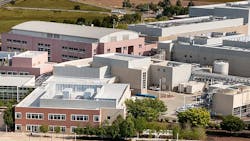Integration of Lonza’s Vacaville biologics site, acquired from Roche in 2024, is progressing
Lonza continues to integrate its facility in Vacaville, California, one of the world’s largest biologics sites dedicated to late-stage clinical and commercial mammalian manufacturing, into the company’s global network. One year after completing the $1.2 billion acquisition of the site from Roche, Vacaville’s integration remains a work in progress.
Vacaville is one of the crown jewels of Lonza’s Integrated Biologics division, positioning the company to benefit as large-scale mammalian capacity is in strong demand. The 956,000-square-foot site spread across 10 buildings has “experienced sustained high customer interest, including the signing of a significant long-term commercial supply agreement” with further signings expected in coming months, Lonza reported in its third-quarter 2025 qualitative update last month.
“Despite some reports suggesting otherwise, Vacaville’s integration into Lonza’s global network is progressing fully in line with its plan,” William Blair analysts wrote in a note to investors last month. The site is “now expected to contribute at the upper end of the company’s guidance range of around CHF 500 million in sales, and margins are proving to be better than management expected going into the year,” according to the analysts.
Diane Vallejos Lever, senior vice president and global head of sales for Lonza Integrated Biologics, told Pharma Manufacturing that the company has committed $500 million in upgrades to the quality system and information technology (IT) infrastructure at the Vacaville facility. The IT systems at the site are being “aligned” to communicate with Lonza’s global mammalian network, Lever said.
“We are in the middle of that now,” she added. “It’s also public knowledge that we had prior commitments to the previous owner [Roche], so we’re in that as well and we continue to look for new customers over the next few years.”
Under the terms of the Vacaville acquisition, products previously manufactured at the site are being supplied by Lonza to Roche with minimum volume commitments over the medium term, which will ultimately phase out over time as the facility transitions to its own customers.
Lonza maintains that Vacaville is showing “strong and consistent operational execution, maintaining its excellent quality track record while advancing preparations for new product introductions.” With the first phase of capital expenditure progressing as planned, the Swiss-headquartered contract development and manufacturing organization (CDMO) intends to make additional investments over the next two to three years to upgrade Vacaville’s automation system and multi-purpose capabilities.
Large bioreactor capacity
Currently, Vacaville is a multi-product cGMP mammalian manufacturing facility with 12,000L and 25,000L stainless steel bioreactors, contributing to a total bioreactor capacity of around 332,000L.
“We have a 12,000L asset and a 25,000L asset,” Philippe Deecke, Lonza’s Chief Financial Officer, told analysts in an earnings call last month. “There were certainly question marks around the market still requiring such large reactors like the 25,000L we have. We’re very pleased to say that, yes, indeed, there is big demand for such large reactors. We see contracting for both our 12,000L reactor and our 25,000L reactor.”
Citing a key opinion leader (KOL) who previously led a large multinational CDMO, Leerink Partners analysts in a note to investors said that stainless steel facilities in the U.S. are drawing new attention due to the potential risk that the Trump administration might impose industry-specific tariffs on pharmaceuticals.
“The KOL noted that large stainless steel (15K-25KL) facilities are now seeing better utilization and interest from sponsors given looming tariff risk and potential repatriation of manufacturing from Asia,” wrote the analysts. “This includes Lonza’s new 332KL Vacaville facility, which the KOL noted had previously struggled to fully commercialize its available capacity, but interest has accelerated due to customers reassessing deals with offshore suppliers such as Samsung and WuXi amid tariff uncertainty.”
Due to onshoring pressure in the U.S., Lever agrees that the “timing has been good” for Vacaville’s large-scale mammalian capacity, with Lonza poised to benefit.
“A lot of it is about tech transfers coming in and just the timing of that, and also how it correlates to all of the upgrades we’re making [at Vacaville] and some minor shutdowns that we’re doing — while making sure we continue production with a proper schedule to bring in new customers,” she said. “We have signed contracts for them, so we have ongoing non-Roche projects.”
About the Author
Greg Slabodkin
Editor in Chief
As Editor in Chief, Greg oversees all aspects of planning, managing and producing the content for Pharma Manufacturing’s print magazines, website, digital products, and in-person events, as well as the daily operations of its editorial team.
For more than 20 years, Greg has covered the healthcare, life sciences, and medical device industries for several trade publications. He is the recipient of a Post-Newsweek Business Information Editorial Excellence Award for his news reporting and a Gold Award for Best Case Study from the American Society of Healthcare Publication Editors. In addition, Greg is a Healthcare Fellow from the Society for Advancing Business Editing and Writing.
When not covering the pharma manufacturing industry, he is an avid Buffalo Bills football fan, likes to kayak and plays guitar.
